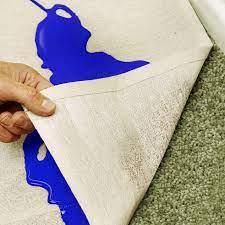Home renovation projects bring excitement—but also a mess. From paint splatters to dust and debris, protecting your floors and furniture is just as important as getting that perfect wall finish. That’s where paint tarps and plastic sheets come into play. Many DIYers and homeowners find themselves wondering: Which option offers better protection during painting and remodeling projects?
In this guide, we’ll break down the pros, cons, and real-world uses of paint tarps, painters drop cloths, and plastic sheets, so you can make an informed choice for your next renovation.
Why Protection Matters in Home Renovation
Renovations involve paint, dust, and heavy tools. A few accidental drops of paint or scratches can turn into expensive repair jobs. Using the right drop cloths or paint tarps ensures:
- Floors stay spotless and damage-free.
- Furniture and décor remain protected.
- Workspaces feel organized and safe.
With the right covering, you reduce stress and keep your focus where it belongs: achieving a great finish.
What Are Paint Tarps?
Paint tarps are heavy-duty fabric coverings, often made from cotton canvas. Also called canvas drop cloths, they’re designed to absorb paint splatters without letting it seep through to the floor.
Key Features:
- Durable and reusable.
- Breathable, so they don’t trap moisture.
- Weighted fabric that stays in place.
- Can double as dust covers or even outdoor use.
Because of their reusability, paint tarps are a long-term investment for both professionals and DIY homeowners.
What Are Plastic Sheets?
Plastic sheets are lightweight covers, usually made of polyethylene. They’re widely available, inexpensive, and disposable. Many homeowners use them as a quick fix to cover large areas during painting or sanding.
Key Features:
- Lightweight and easy to spread out.
- Waterproof—paint won’t seep through.
- Disposable after one use.
- Available in rolls or folded packs.
While they seem practical at first glance, plastic sheets have drawbacks that every renovator should consider.
Paint Tarps Vs. Plastic Sheets: Key Differences
Let’s compare them in terms of protection, safety, cost, and sustainability.
1. Protection
- Paint Tarps (Canvas Drop Cloths): Absorb paint splatters and prevent seepage. Great for protecting hardwood, tile, and carpet.
- Plastic Sheets: Block paint completely but are prone to tearing and shifting.
✅ Winner: Paint Tarps (stronger, reliable coverage).
2. Safety During Work
- Paint Tarps: Heavy enough to stay in place. Less likely to cause slips.
- Plastic Sheets: Slippery surface, especially if paint drips. Dangerous if ladders or heavy tools are involved.
✅ Winner: Paint Tarps (safer underfoot).
3. Cost and Longevity
- Paint Tarps: Higher upfront cost but reusable for years.
- Plastic Sheets: Cheap, but often single-use and not eco-friendly.
✅ Winner: Paint Tarps (better long-term value).
4. Eco-Friendliness
- Paint Tarps: Washable, reusable, biodegradable (cotton).
- Plastic Sheets: Disposable, add to landfill waste.
✅ Winner: Paint Tarps (sustainable choice).
When Plastic Sheets Make Sense
Even though paint tarps outperform plastic in most areas, there are scenarios where plastic sheets can be useful:
- Covering walls, doors, or windows from paint mist.
- Short-term, small DIY jobs.
- Protecting outdoor items from rain or dust.
Think of plastic sheets as a temporary shield, while canvas drop cloths are long-term armor.
Why Most Pros Recommend Paint Tarps
Professional painters and contractors almost always reach for canvas drop cloths instead of plastic. Why?
- They stay flat without tape.
- Safer for walking and moving ladders.
- Can handle repeated use across multiple jobs.
- Add a level of professionalism to the workspace.
For serious DIYers, investing in a paint drop cloth pays off by saving time, money, and frustration.
A Smart Approach: Combine Both
Sometimes, the best option is using both strategically. For example:
- Lay paint tarps on floors where you’ll be walking and moving ladders.
- Use plastic sheets on walls, ceilings, or furniture.
This way, you get maximum protection with safety and cost efficiency.
Finding Quality Paint Tarps
Many DIYers wonder where to find high-quality canvas drop cloths that balance durability and affordability. That’s where trusted providers like CoverNpaint in the USA step in. They specialize in professional-grade canvas drop cloths and tool aprons built for both homeowners and contractors. With features like reinforced stitching and heavy-duty cotton fabric, options from CoverNpaint are designed to last through project after project—making them a smarter investment compared to disposable alternatives.
FAQs (Snippet-Friendly)
Q1: Are paint tarps reusable?
Yes, canvas paint tarps are highly reusable and can last through multiple projects with proper care.
Q2: Do plastic sheets protect floors better than drop cloths?
Plastic sheets block paint but tear easily and can be slippery. Drop cloths provide stronger, safer protection.
Q3: What size drop cloth should I buy for painting a room?
For standard rooms, a 9x12 ft canvas drop cloth works best. Larger projects may need multiple tarps.
Q4: Can I wash a painters drop cloth?
Yes, most canvas drop cloths are washable, which makes them eco-friendly and long-lasting.
Q5: Which is more cost-effective: tarps or plastic sheets?
Tarps cost more upfront but save money long-term due to their reusability, while plastic sheets are single-use.

